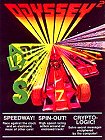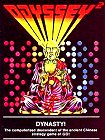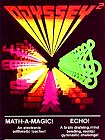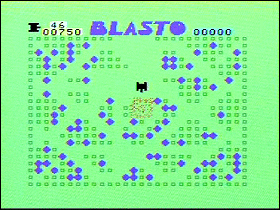Las Vegas Blackjack!
 The Game: Place your bets, ditch some cards, or play with the ones you’ve got. The computer offers the usual enticements – double down and insurance – but the odds are firmly in favor of the house. There’s no limit on how big your bet is, so you’re even free to bet an ante that’ll have you screaming “uncle!” if you lose. (Magnavox, 1978)
The Game: Place your bets, ditch some cards, or play with the ones you’ve got. The computer offers the usual enticements – double down and insurance – but the odds are firmly in favor of the house. There’s no limit on how big your bet is, so you’re even free to bet an ante that’ll have you screaming “uncle!” if you lose. (Magnavox, 1978)
Memories: I’m not a big fan of card games. In fact, when I got hold of this rather common cartridge recently, the lovely Mrs. PDF actually had to teach me how to play blackjack. I was hopeless. But it’s grown on me. I’ve now had the opportunity to play both this Odyssey 2 version and a Game Boy Color edition which is part of a card game cartridge called Las Vegas Cool Hand. And I have to say I like the Odyssey version better. [read more]

 The Game: In Speedway!, one player guides a race car through an endless onslaught of slower-moving traffic, Monaco GP style; colliding with anyone stalls the game for a moment. Two players are required for Spin-Out!, a copycat of Atari’s Sprint 2 coin-op, in which two race cars zip around a convoluted little track in an attempt to be the first one to rack up three laps. Crypto-Logic! lets you type in up to 18 characters on one line, and hit the enter key to completely scramble those characters. A second player then has to figure out what the jumble of letters was with as few misses as possible. (Magnavox, 1978)
The Game: In Speedway!, one player guides a race car through an endless onslaught of slower-moving traffic, Monaco GP style; colliding with anyone stalls the game for a moment. Two players are required for Spin-Out!, a copycat of Atari’s Sprint 2 coin-op, in which two race cars zip around a convoluted little track in an attempt to be the first one to rack up three laps. Crypto-Logic! lets you type in up to 18 characters on one line, and hit the enter key to completely scramble those characters. A second player then has to figure out what the jumble of letters was with as few misses as possible. (Magnavox, 1978) The Game: Purporting to be based on the ancient Chinese game of Go, Dynasty! is actually more of a variation of Othello. The same strategies apply, and can be played with two players, one against the computer, or – for those who are feeling a little bit lazy – the computer vs. itself. (Magnavox, 1979)
The Game: Purporting to be based on the ancient Chinese game of Go, Dynasty! is actually more of a variation of Othello. The same strategies apply, and can be played with two players, one against the computer, or – for those who are feeling a little bit lazy – the computer vs. itself. (Magnavox, 1979) The Game: Wow! We must be in the future, for we now have electronic flash cards! This is more or less the function fulfilled by Math-A-Magic, while Echo is a slightly watered down version of the classic electronic game Simon. (Magnavox, 1979)
The Game: Wow! We must be in the future, for we now have electronic flash cards! This is more or less the function fulfilled by Math-A-Magic, while Echo is a slightly watered down version of the classic electronic game Simon. (Magnavox, 1979) The Game: Zylon warships are on the rampage, blasting allied basestars out of the sky and wreaking havoc throughout the galaxy. Your orders are to track down the fast-moving raiders and destroy them before they can do any more damage. You have limited shields and weapons at your disposal, and a battle computer which is vital to your mission (though critical damage to your space fighter can leave you without that rather important piece of equipment). The game is simple: destroy until you are destroyed, and defend friendly installations as long as you can. (Atari, 1979)
The Game: Zylon warships are on the rampage, blasting allied basestars out of the sky and wreaking havoc throughout the galaxy. Your orders are to track down the fast-moving raiders and destroy them before they can do any more damage. You have limited shields and weapons at your disposal, and a battle computer which is vital to your mission (though critical damage to your space fighter can leave you without that rather important piece of equipment). The game is simple: destroy until you are destroyed, and defend friendly installations as long as you can. (Atari, 1979) The Game: An elaborate game of tag, only the simian players have an advantage; human players, when tagged, must be “un-tagged” by the other player to return to the game. (Magnavox, 1980)
The Game: An elaborate game of tag, only the simian players have an advantage; human players, when tagged, must be “un-tagged” by the other player to return to the game. (Magnavox, 1980) The Game: In the opening screen – the mists of time, so the rulebook tells us – two players pick their characters’ classes. Warriors are sword-wielding strongmen, wizards can cast spells from a distance, phantoms can walk through solid walls (but not lava formations), and changelings can become invisible when they move. The two intrepid adventurers then set forth on a quest to retrieve the ten rings of power from randomly selected dungeons and filled with randomly selected horrors. (Magnavox, 1980)
The Game: In the opening screen – the mists of time, so the rulebook tells us – two players pick their characters’ classes. Warriors are sword-wielding strongmen, wizards can cast spells from a distance, phantoms can walk through solid walls (but not lava formations), and changelings can become invisible when they move. The two intrepid adventurers then set forth on a quest to retrieve the ten rings of power from randomly selected dungeons and filled with randomly selected horrors. (Magnavox, 1980) The Game: You start the game by creating a character, Basic D&D style, who enters the world defenseless and just this side of naked. It’s your job to arm and armor your alter-ego, buy plenty of rations, and then set out to explore the world of Britannia, and the treacherous dungeons that lie beneath it. A visit to the castle of Lord British will give you a chance to level up for deeds accomplished, and receive an assignment from him for your next adventure. (California Pacific Computer, 1980)
The Game: You start the game by creating a character, Basic D&D style, who enters the world defenseless and just this side of naked. It’s your job to arm and armor your alter-ego, buy plenty of rations, and then set out to explore the world of Britannia, and the treacherous dungeons that lie beneath it. A visit to the castle of Lord British will give you a chance to level up for deeds accomplished, and receive an assignment from him for your next adventure. (California Pacific Computer, 1980) The Game: Piloting your mobile cannon around a cluttered playfield, you have but one task: clear the screen of mines, without blowing yourself up, in the time allotted. If you don’t clear the screen, or manage to detonate a mine so close to yourself that it takes you out, the game is over. If you do clear all the mines, you get a free chance to try it again. Two players can also try to clear the minefield simultaneously. (Texas Instruments, 1980)
The Game: Piloting your mobile cannon around a cluttered playfield, you have but one task: clear the screen of mines, without blowing yourself up, in the time allotted. If you don’t clear the screen, or manage to detonate a mine so close to yourself that it takes you out, the game is over. If you do clear all the mines, you get a free chance to try it again. Two players can also try to clear the minefield simultaneously. (Texas Instruments, 1980) The Game: You find yourself outside an inviting two-story house, and when you go in, you find several people waiting for you – and that inviting front door suddenly locked behind you. When dead bodies turn up on the second floor and night begins to fall (hope you found the matches in the cupboard already!), it quickly becomes apparent that among the friendly faces of the first floor is a cold-blooded killer. (On-Line Systems, 1980)
The Game: You find yourself outside an inviting two-story house, and when you go in, you find several people waiting for you – and that inviting front door suddenly locked behind you. When dead bodies turn up on the second floor and night begins to fall (hope you found the matches in the cupboard already!), it quickly becomes apparent that among the friendly faces of the first floor is a cold-blooded killer. (On-Line Systems, 1980)